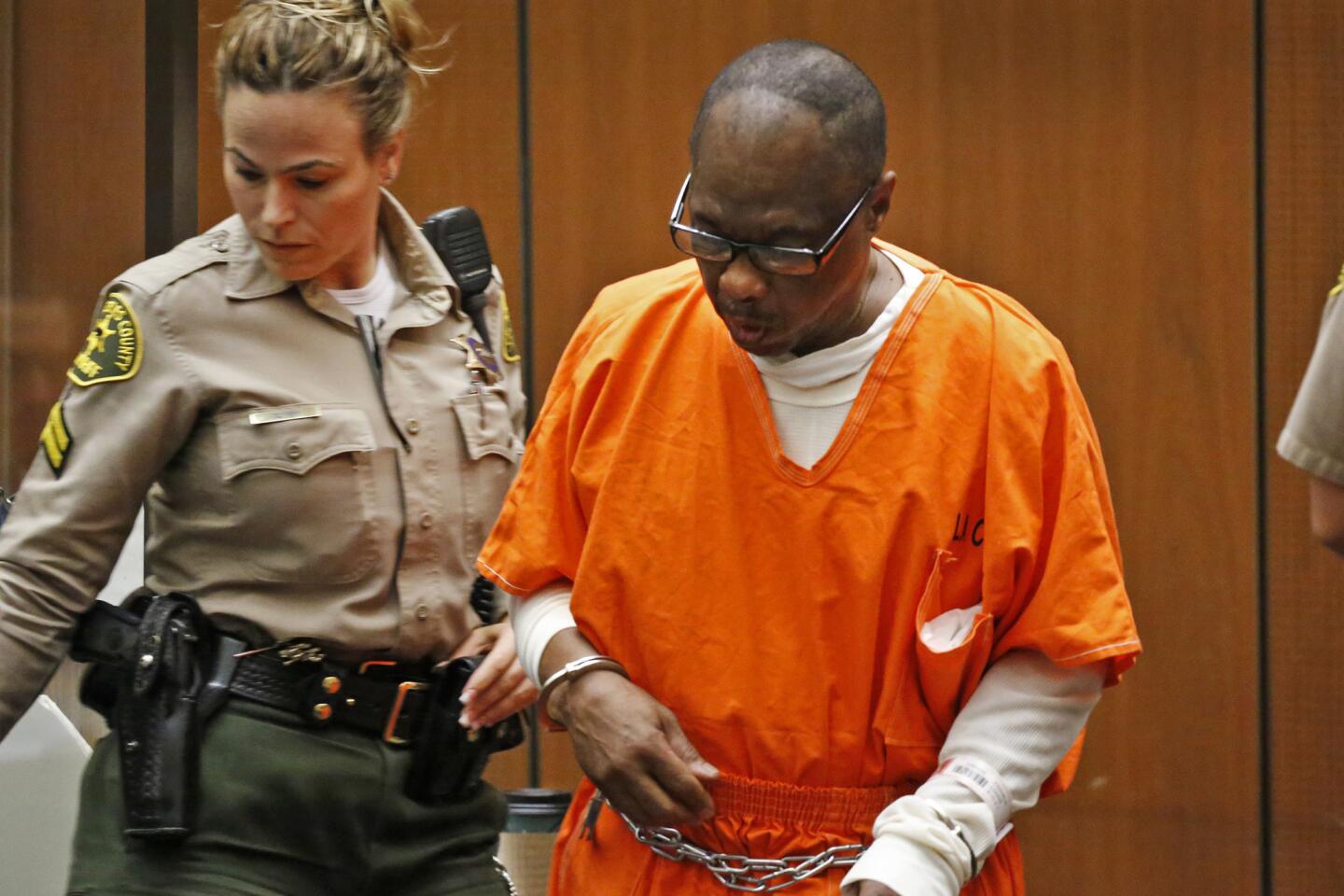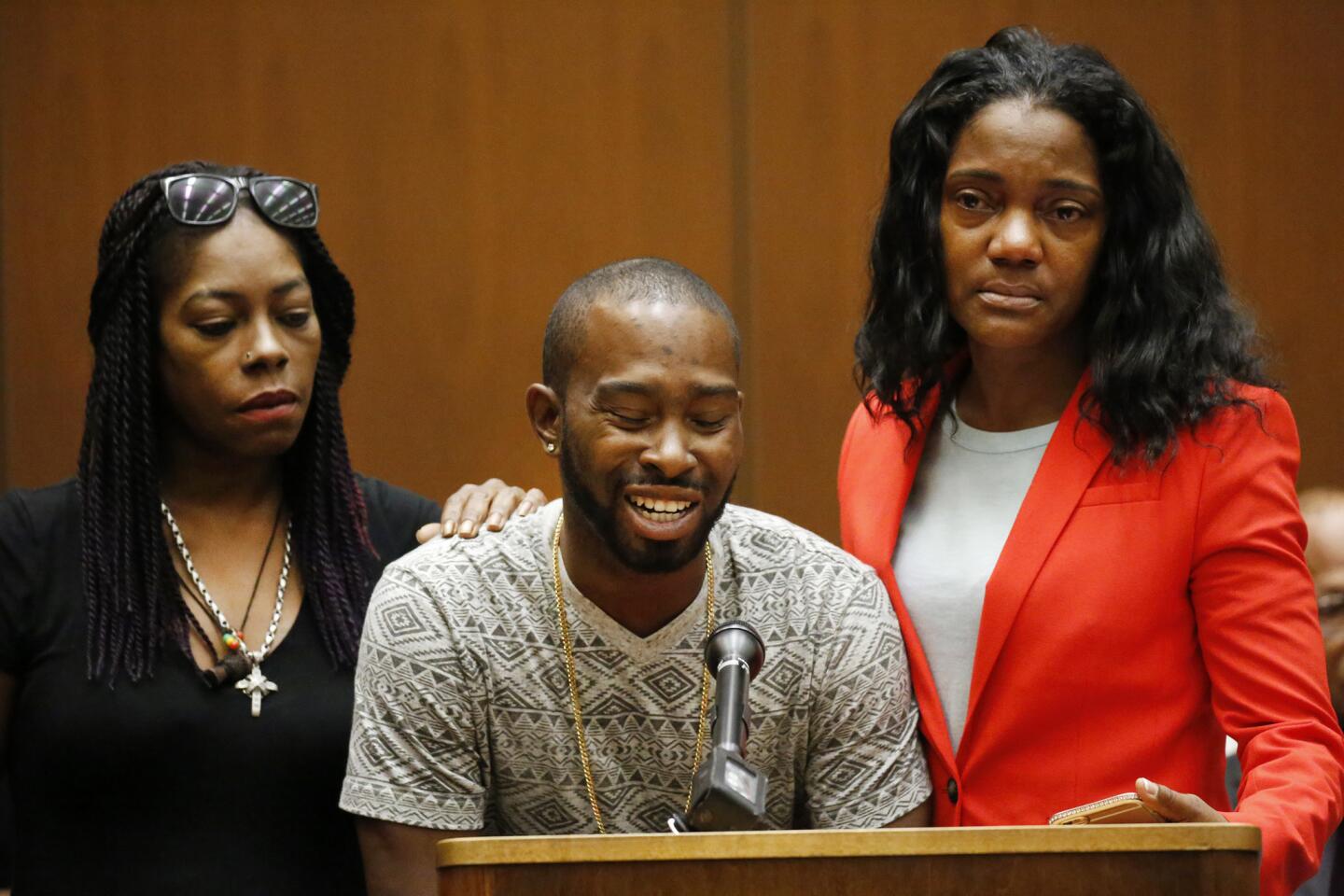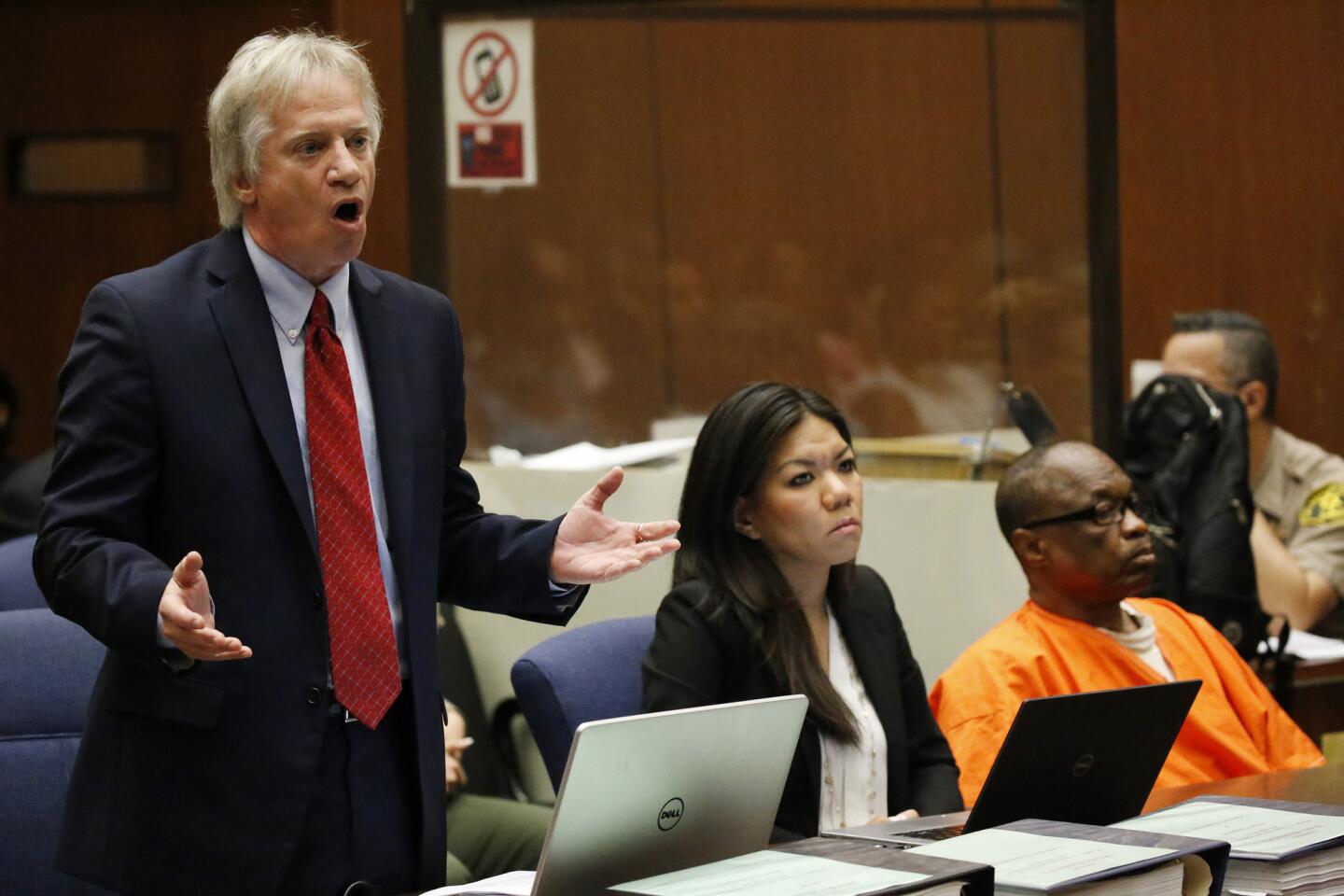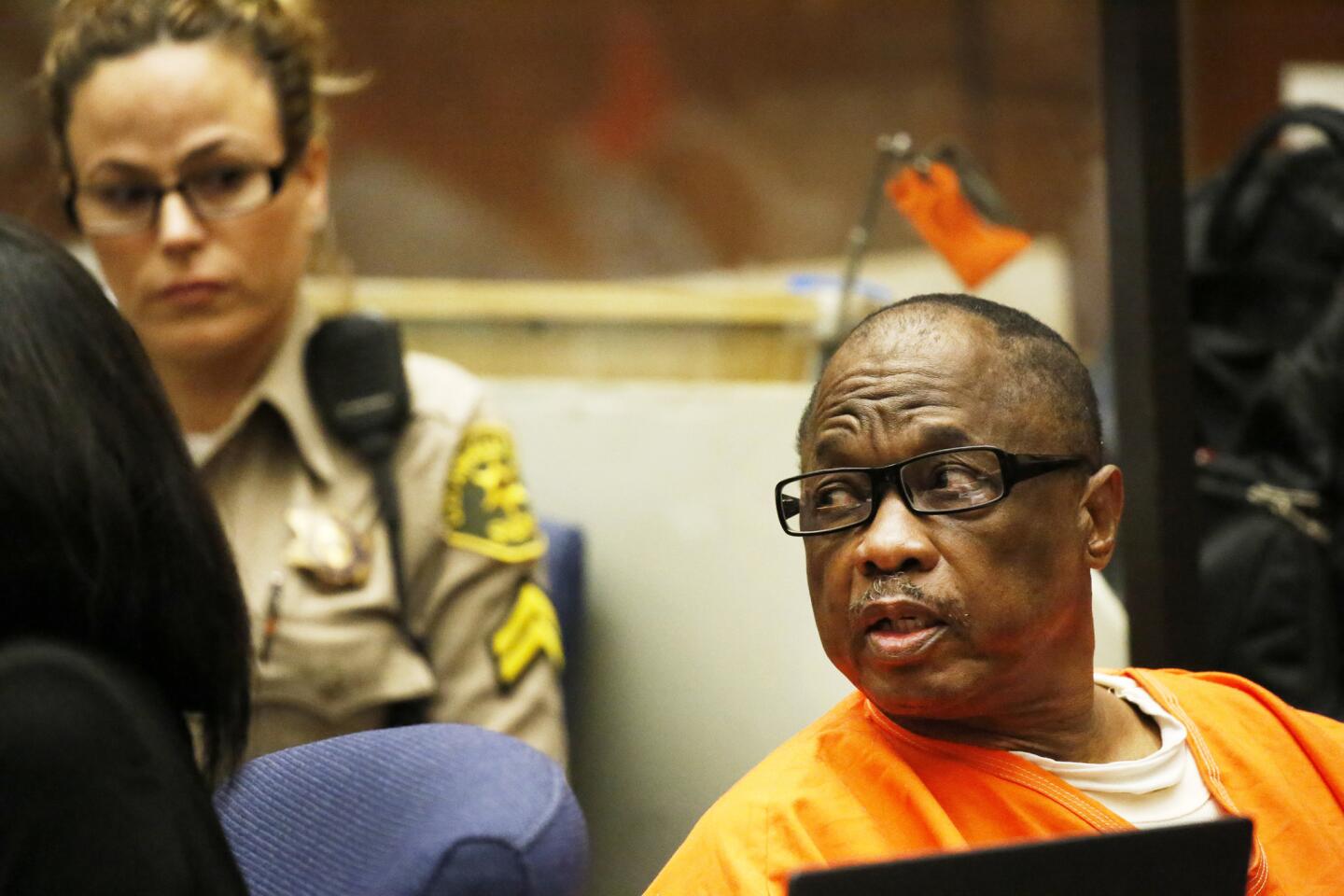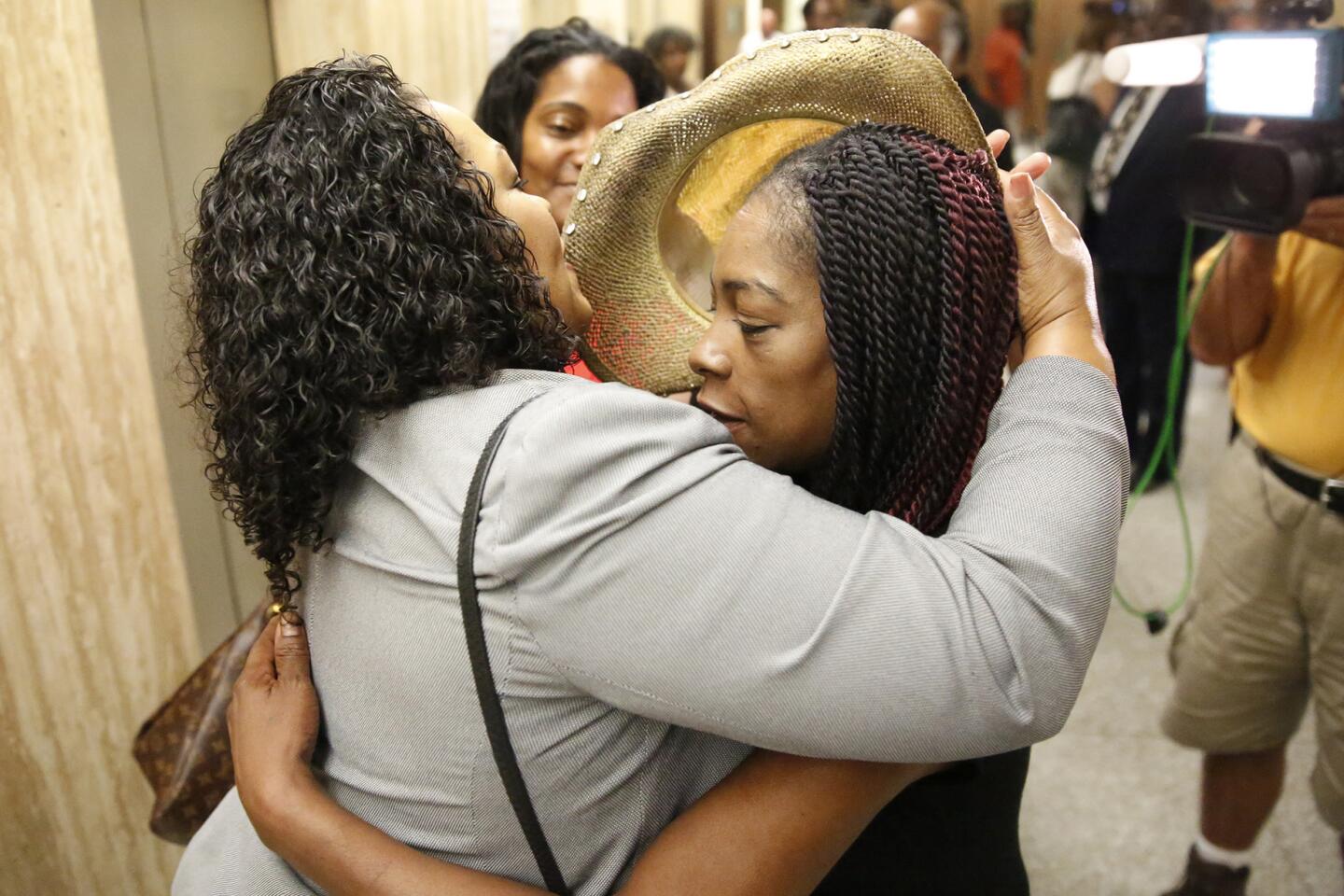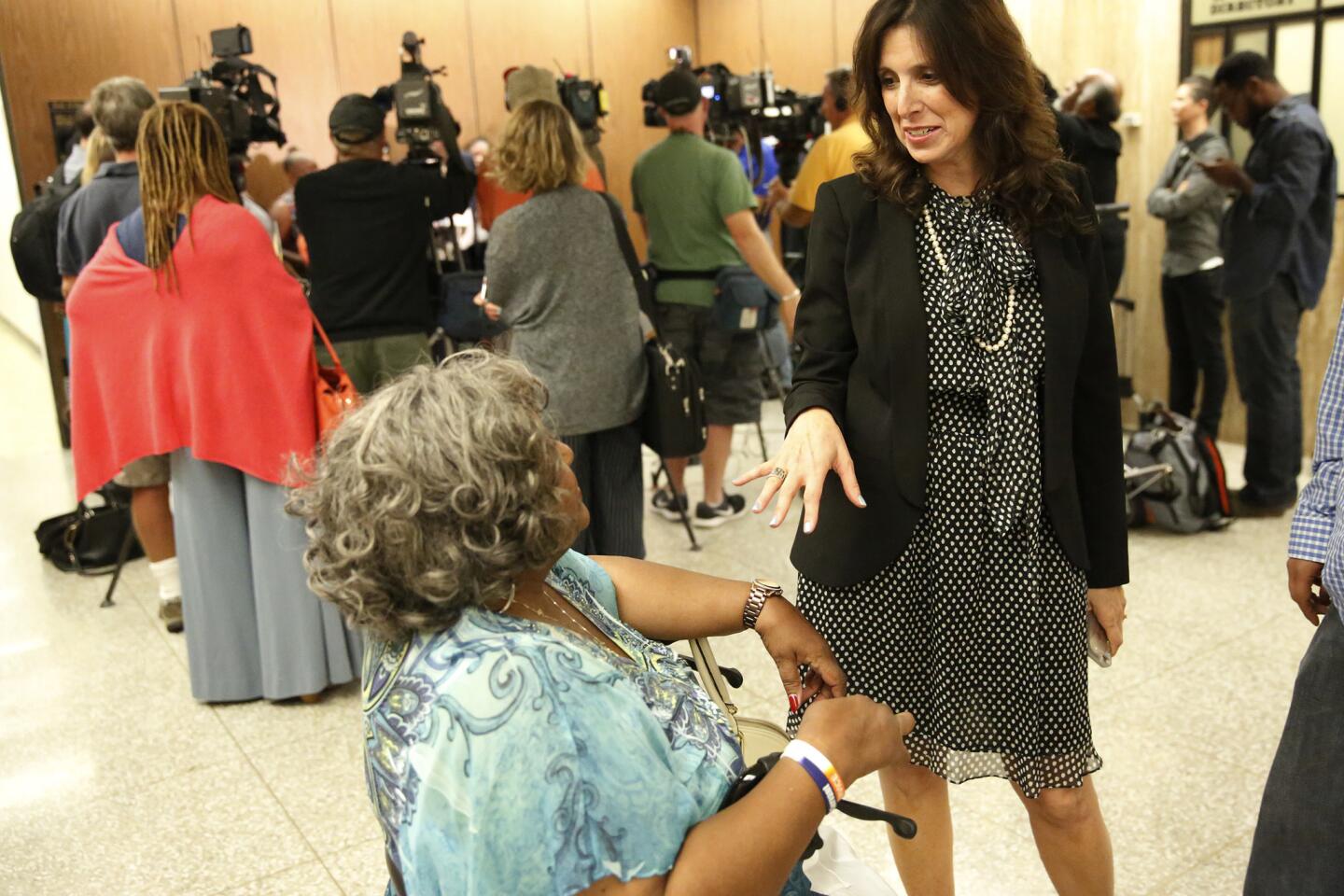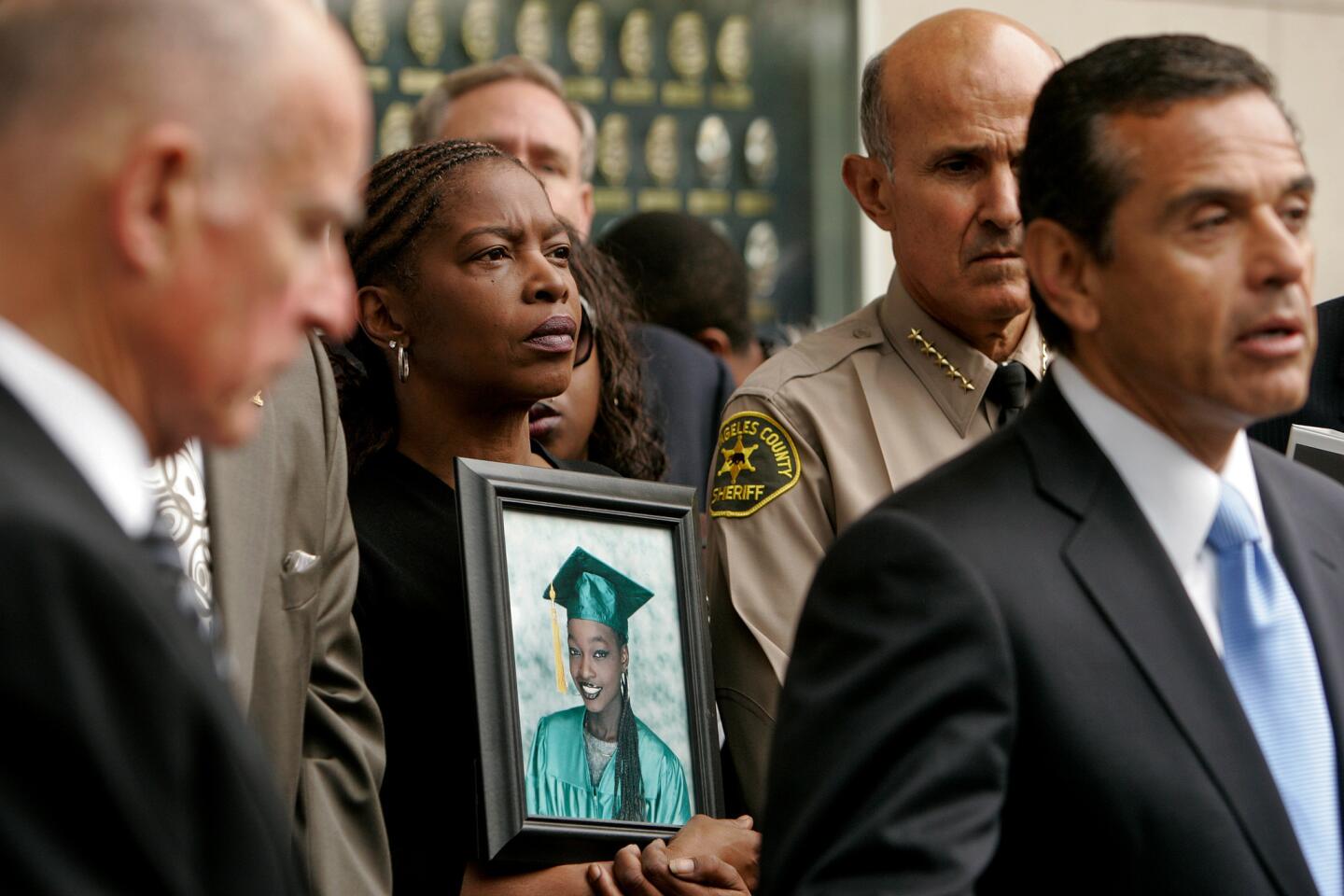The ‘Grim Sleeper’ is sentenced to death for string of murders
- Share via
A man approached Laura Moore at a bus stop in the spring of 1984 and offered a warning: You shouldn’t be out here alone.
“Bad guys will pick you up,” he told her. “Let me take you where you have to go.”
Moore, then 21, agreed, reluctantly. As the man drove off, he told her to put on her seat belt. When she refused, she said, he reached under his seat, grabbed a gun and shot her six times. Wounded, she managed to escape, but turned back to study his face. That man, Moore said, was Lonnie David Franklin Jr., now better-known as the “Grim Sleeper” serial killer.
She recounted the story in court Wednesday at a hearing where Franklin was sentenced to death, capping a lengthy legal saga that centered on the gruesome killings of more than a dozen women in South L.A.
“This is not a sentence of vengeance,” Superior Court Judge Kathleen Kennedy told Franklin as relatives of his victims looked on, some of them in tears. “It’s justice.”
Franklin, 63, was convicted earlier this year of killing nine women and a teenage girl from 1985 to 2007. During the penalty phase of his trial, prosecutors connected him to several additional slayings. Detectives believe he may have killed at least 25 women.
The judge read the names of the 10 victims Franklin was found guilty of killing. In each case, Kennedy told him, “You shall suffer the death penalty.”
As she spoke, some of the victims’ relatives cried, others sighed. One man repeated: “Amen, amen, amen.”

At a news conference after Lonnie Franklin Jr. was sentenced to death, family members of the victims and one woman who testified speak about the trial’s end.
The sentence came toward the end of an emotional hearing where more than a dozen family members and friends of victims read statements, many of them repeatedly asking why Franklin chose to attack members of his own community.
“The defendant took my daughter, murdered her, put her in a plastic bag — a trash bag — like she was trash,” Laverne Peters, whose 25-year-old daughter was found in a garbage bin in 2007, told the court before Franklin was sentenced. “My hope is that he spends the rest of his glory days in his jail cell, which will become his trash bag.”
“Amen,” other family members in the audience said.
Five of the jurors who convicted Franklin attended, occasionally nodding. Before the hearing, one of the victim’s sisters thanked a juror and said, “God bless you.” The juror winked at her.
During the hearing, a woman spoke of losing her best friend, but said she still hears her voice in dreams. A victim’s uncle said he remembered how loudly she used to cry when he babysat her as a child — a reminder, he said, of how she did everything in her life passionately. At one point, the nephew of Henrietta Wright, whose body was found under a mattress in an alleyway in 1986, addressed Franklin directly, saying, “You’re a cold-hearted dude.” Franklin nodded slightly.
When Moore, the surviving victim, addressed Franklin, her body began to shake.
“Why, why, why?” she asked. “Really, why?”
Moore wasn’t listed in the criminal complaint against Franklin, but Los Angeles police Det. Daryn Dupree — the last remaining detective who worked on the task force that investigated the Grim Sleeper killings — said he is “very confident” that she is one of his victims.
Franklin sat stoically as Kennedy sentenced him — just as he had throughout the trial. But earlier in the morning, he did react to statements delivered by some of the victims’ relatives.
Mary Alexander, whose 18-year-old daughter was murdered, spoke directly to Franklin.
“I’d like for Mr. Franklin to turn around and face me,” she said.
Franklin turned his head slowly, locking eyes with Alexander.
“I’d like to know, why?” Alexander asked, gripping the lectern.
Franklin whispered something in response.
She repeated her question, louder: “Why?”
Again, he whispered. (Dupree told reporters after the hearing that he saw Franklin mutter, “I didn’t do it.”)
“I know she didn’t do anything to hurt you,” Alexander told Franklin, “I know that.”
Franklin’s face softened and he nodded.
Alexander told Franklin that she had thought a lot about forgiveness but said she was finding the concept extremely difficult.
“I’m still battling that,” Alexander said.
Franklin nodded once more and turned back toward the judge.
When another victim’s sister told Franklin that she recognized him, he got angry, shouting, “That’s a bald-faced lie.”
In imposing the sentence, Kennedy said she had struggled throughout the case to understand what motivated Franklin.
“It doesn’t matter why,” she said. “There could never be a justification for what you have done.”
The killer, one of California’s most prolific, targeted victims who were generally young, vulnerable and, at times, ignored. The attacks failed to raise alarms the way other famous serial slayings by killers such as the “Hillside Strangler” or the “Night Stalker” did.
The deaths in the mid- to late ’80s coincided with a surge in slayings linked to the crack cocaine epidemic. In addition, several other serial killers were operating in the same area in those years. Michael Hughes was convicted of killing seven women; Chester Turner of 14 women and a fetus. Both are on California’s death row.
But the Grim Sleeper proved to be the most persistent. He targeted women who were drug addicts or prostitutes and often dumped their naked bodies alongside roads or in the trash. Many of the women were initially listed as Jane Does. The deaths drew little, if any, media attention.
Police kept the slayings quiet despite suspicions that a serial killer was stalking black women — a decision that led to outrage and condemnation from many who attribute Franklin’s longevity as a killer to police indifference.

More than 1,000 photographs were found in the home of Lonnie Franklin Jr., the serial killer known as the Grim Sleeper. Some were released to the public to help identify the women. Thirty-five women remain unidentified.
Authorities were able to link the slayings through ballistic and genetic evidence at the crime scenes that pointed to a single killer. But identifying the DNA proved difficult.
A break finally came in the case in 2010, when a search of state offender records turned up a partial match. The person wasn’t the suspected serial killer, but a close relative was.
Before long, investigators focused on the convict’s father, Franklin. After tailing him to a pizza joint in Buena Park during the summer of 2010, police collected a slice of partially eaten pizza. They tested it for DNA and, finally, had a match.
A search of Franklin’s home on 81st Street — not far from the South L.A. corridor where many of the victims’ bodies were found — turned up a .25-caliber semiautomatic handgun. Two criminalists testified at trial that it was same weapon that killed one of the victims.
Franklin’s attorney, Seymour Amster, told jurors that DNA from other men was found at some crime scenes — a sign, he said, that someone else could have played a role in the slayings.
In May, a jury convicted Franklin of 10 counts of murder. His victims, in order of death, were: Debra Jackson, 29; Henrietta Wright, 35; Barbara Ware, 23; Bernita Sparks, 25; Mary Lowe, 26; Lachrica Jefferson, 22; Alicia Alexander, 18; Princess Berthomieux,15; Valerie McCorvey, 35; and Janecia Peters, 25.
Most of the women were shot to death. Berthomieux was strangled.
Franklin was also convicted of attempted murder in connection with an attack on Enietra Washington, who survived and testified against him.
“You’re truly a piece of evil,” Washington told Franklin Wednesday. “You’re a Satan representative… You’re right up there with Manson.”
Franklin initially earned the “Grim Sleeper” nickname because a gap in the killings between 1988 and 2002 suggested he had gone dormant. But detectives believe Franklin never really “slept.”
After the initial conviction, prosecutors presented more evidence against Franklin during the penalty phase of the trial. A woman testified that Franklin, as a U.S. Army private stationed abroad, was one of three assailants who gang-raped her in Germany in 1974.
The high-stakes trial devolved at times into bitter back-and-forths between attorneys, and the discord continued Wednesday.
Before the sentencing, Amster made two last-ditch efforts to keep his client off death row. Kennedy quickly shot down a motion for a new trial based on allegations of prosecutorial misconduct as well as a motion calling for a sentence of life without parole instead of death.
Hours after the sentencing, Amster released a written statement decrying the death penalty in California as a pointless waste of tax dollars.
“Considering the outcomes are often the same since the inmates will almost certainly die from causes other than execution,” Amster said in the statement, “the only significant difference is the millions of dollars wasted on a death verdict.”
California’s death penalty has been the subject of intense legal battles in recent years — there are 746 people on California’s death row, and no one has been executed in the state since 2006.

Lonnie David Franklin Jr., better known as the “Grim Sleeper,” has been sentenced to death.
Follow us on Twitter: @marisagerber, @JamesQueallyLAT
ALSO
Vietnamese comedian visiting O.C. is convicted of sexually assaulting boy
Suspect shot dead by police in Boyle Heights was 14-year-old boy, coroner says
2 attempted kidnappings of children in Glendale have police and parents on alert
UPDATES:
3:35 p.m.: This article was updated with more details from the hearing and some rewriting.
2:20 p.m.: This article was updated with a statement from Franklin’s attorney.
2:03 p.m.: This article was updated with additional details about California’s use of the death penalty and a statement from Franklin’s attorney.
12:55 p.m.: This article was updated with additional details about the sentencing hearing.
12:17 p.m.: This article was updated with additional details from the sentencing hearing.
11:40 a.m.: This article was updated with more details about the hearing.
11:15 a.m.: This article was updated with Franklin receiving the death penalty.
11:00 a.m.: This article was updated with more details about relatives of victims speaking at the hearing.
10:20 a.m.: This article was updated with a description of relatives of victims speaking at the hearing.
This article was originally published at 4 a.m.
More to Read
Sign up for Essential California
The most important California stories and recommendations in your inbox every morning.
You may occasionally receive promotional content from the Los Angeles Times.
